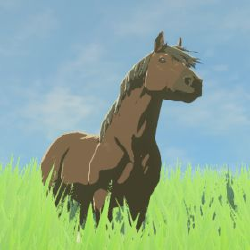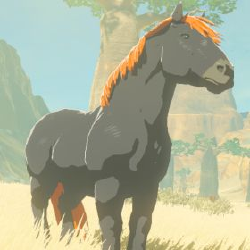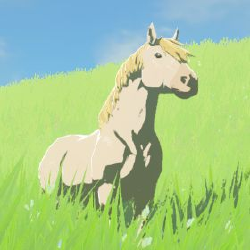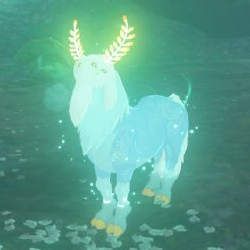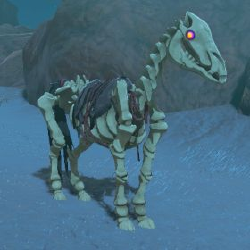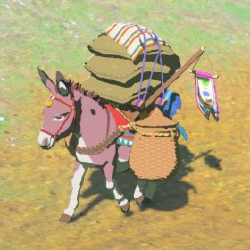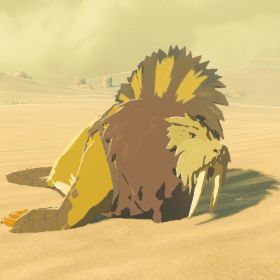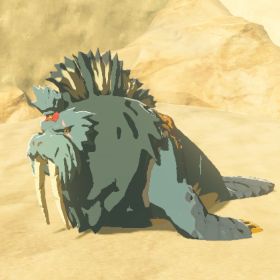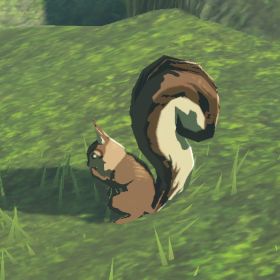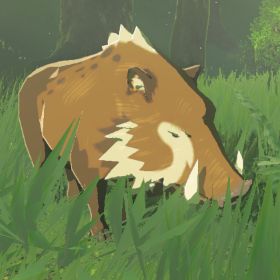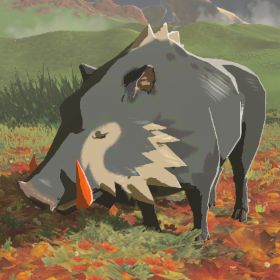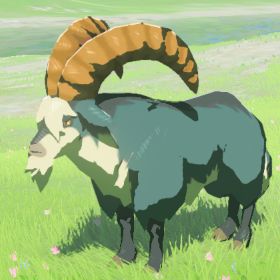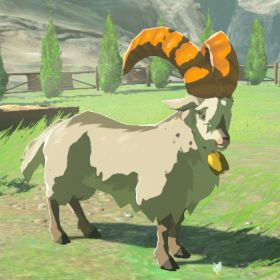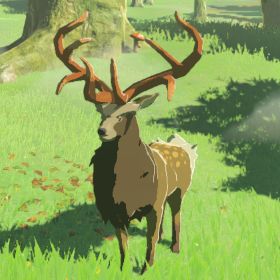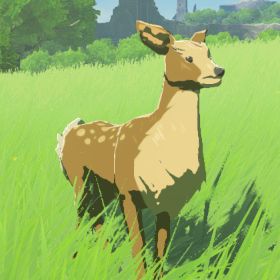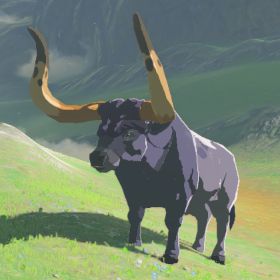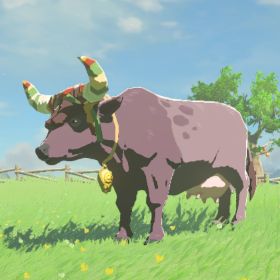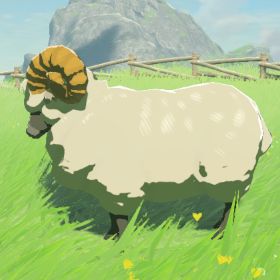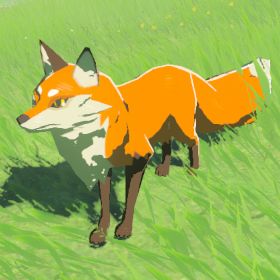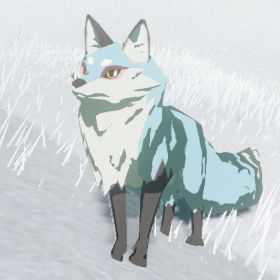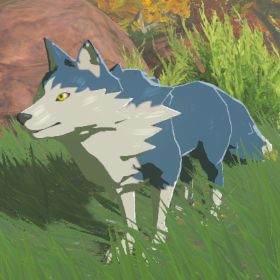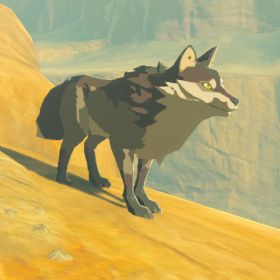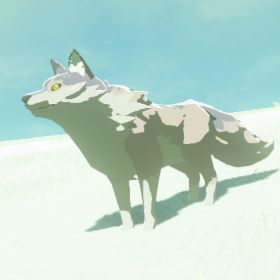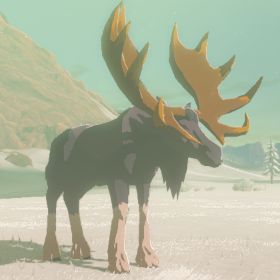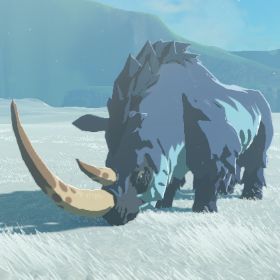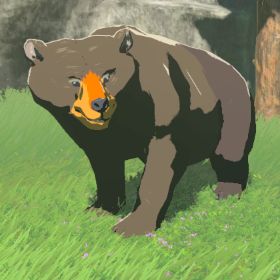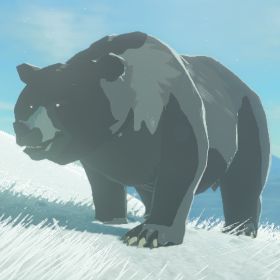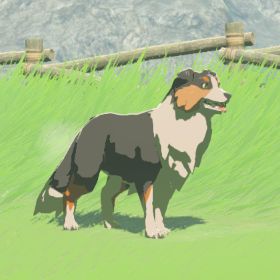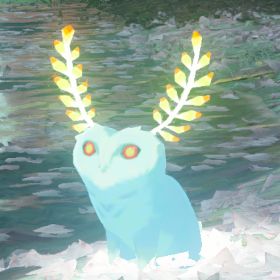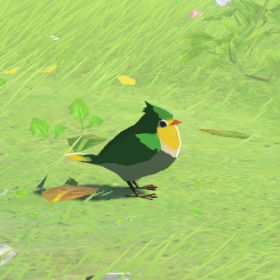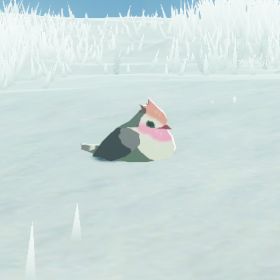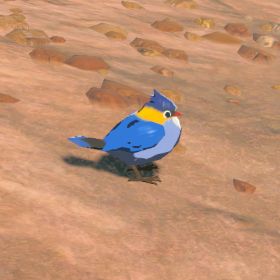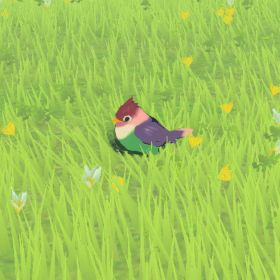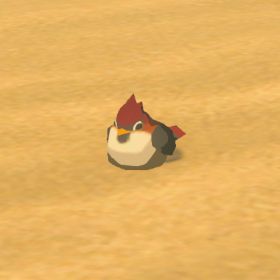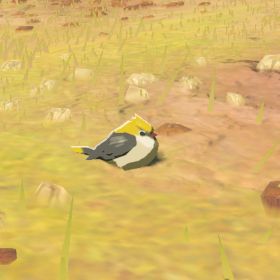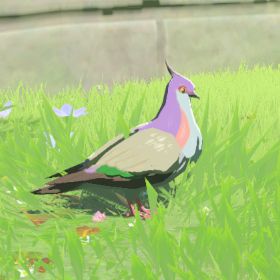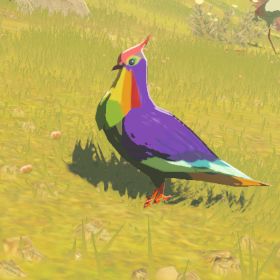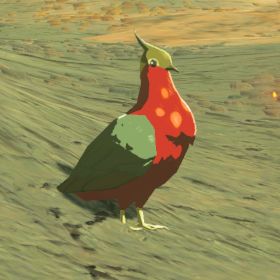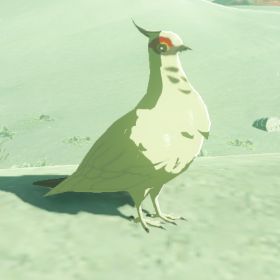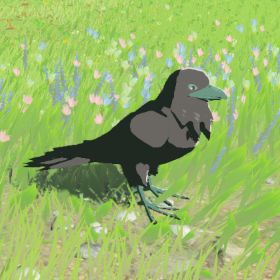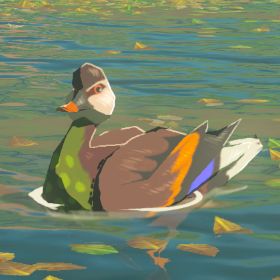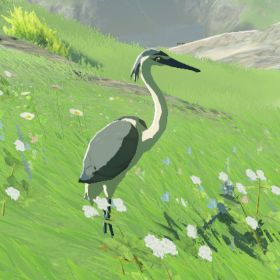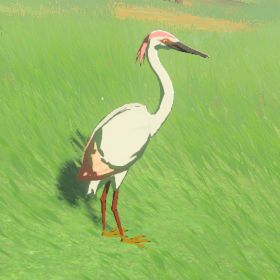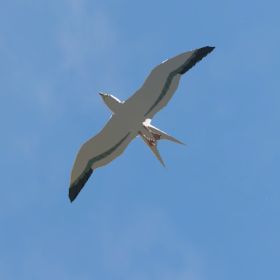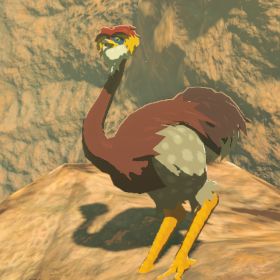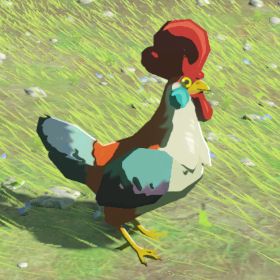Breath of the Wild Animals: Difference between revisions
mNo edit summary |
(Staging the new format until BotW is ready to migrate) |
||
| Line 1: | Line 1: | ||
This is a list of animals found in ''[[The Legend of Zelda: Breath of the Wild|Breath of the Wild]]''. | |||
=== Horse === | |||
{{ | [[File:Horse.png|right]] | ||
{{Main|Horse}} | |||
These can most often be found on plains. Their usefulness as transportation has made them valuable since ancient times. That said, wild horses do tend to get spooked on and run off when approached, so if you're looking to snag one, it's best to sneak up on it. | |||
{{Clear}} | |||
=== Giant Horse === | |||
[[File:Giant-horse.png|right]] | |||
{{ | {{Main|Giant Horse}} | ||
This giant horse is the last of its kind. Its physical capabilities completely overshadow those of regular horses, but its temperament is extremely wild. Only a truly skilled rider can train, or even catch, this beast of a mount. This is a horse that chooses its rider. | |||
{{Clear}} | |||
{{ | === White Horse === | ||
[[File:White-horse.png|right]] | |||
{{Main|White Horse}} | |||
The Hyrulean royal family that perished 100 years ago would sometimes ride atop white horses as a display of their divine right. This white horse may be a descendant of one once ridden by royalty. | |||
{{ | {{Clear}} | ||
=== Lord of the Mountain === | |||
{{ | [[File:Lord-of-the-mountain.png|right]] | ||
{{Main|Lord of the Mountain}} | |||
This noble creature watches over all animals that make their homes in the forest. Legends say this holy creature us a reincarnation of a sage that died on the lands it now protects. It has an acute awareness of its surroundings, so it seldom appears before people. It's sometimes known by its other name, Satori. | |||
{{Clear}} | |||
=== Stalhorse === | |||
[[File:Stalhorse.png|right]] | |||
{{ | {{Main|Stalhorse}} | ||
This skeletal horse is ridden by monsters. It was once a regular horse, but Ganon's power revived it from death. It cannot maintain its bone structure in the daytime. | |||
{{Clear}} | |||
{{ | |||
=== Donkey === | |||
[[File:Donkey.png|right]] | |||
{{ | {{Main|Donkey}} | ||
Smaller than horses, these are raised as livestock in the countryside, so they don't exist in the wild. They're more powerful than they look and specialize in transporting baggage. This has made them popular with travelling merchants. | |||
{{Clear}} | |||
{{ | |||
=== Sand Seal === | |||
[[File:Sand-seal.jpg|right]] | |||
{{Main|Sand Seal}} | |||
{{ | These seals use their large flippers to move through the sand as if swimming. They were once wild animals but have since been domesticated by the Gerudo. They rely on their excellent hearing to find their way while submerged in the sand. Their large, distinct tusks look pretty ferocious, but their favorite food is actually fruit. | ||
{{Clear}} | |||
=== Patricia === | |||
{{ | [[File:Patricia.jpg|right]] | ||
{{Main|Patricia}} | |||
This is Riju's own sand seal. It may look intense, but she dotes on it regularly; the ribbon it wears was a gift from her, and it even has its own pen in Gerudo Town. It's far more agile than any other sand seal and far more outgoing. An ever-reliable partner to Riju, Patricia is always ready to take off through the desert at a moment's notice. | |||
{{ | {{Clear}} | ||
=== Bushy-Tailed Squirrel === | |||
[[File:Bushy-tailed-squirrel.jpg|right]] | |||
{{Main|Bushy-Tailed Squirrel}} | |||
These small creatures are known for their large tails. They tend to live in forests and subsist on acorns and other nuts. They carry their food in their mouths but will sometimes drop it when surprised in an adorable display of shock. | |||
{{Clear}} | |||
=== Woodland Boar === | |||
[[File:Woodland-boar.jpg|right]] | |||
{{Main|Woodland Boar}} | |||
These medium-sized beasts can be found all throughout Hyrule. You can most often find them foraging for food in forests or meadows. Although usually docile, they won't hesitate to charge you full force if you get too close. | |||
{{Clear}} | |||
=== Red-Tusked Boar === | |||
[[File:Red-tusked-boar.jpg|right]] | |||
{{Main|Red-Tusked Boar}} | |||
These boars are known for their red tusks and black fur. They're similar to your average boars but are considerably stronger. Extra caution is advised when hunting these. | |||
{{Clear}} | |||
=== Mountain Goat === | |||
[[File:Mountain-goat.jpg|right]] | |||
{{Main|Mountain Goat}} | |||
These herbivores make their homes in meadows and rock areas. Their characteristically strong legs and hooves facilitate easy climbing over rocks. Goats aren't very quick, so they make good targets for beginning hunters. | |||
{{Clear}} | |||
=== White Goat === | |||
[[File:White-goat.jpg|right]] | |||
{{Main|White Goat}} | |||
These goats are raised for their multiple uses. Their milk can be drank or made into butter, and their soft fur is used to make clothes. Domesticated goats wear bells around their necks so they can be easily found after being let out to graze. | |||
{{Clear}} | |||
=== Mountain Buck === | |||
[[File:Mountain-buck.jpg|right]] | |||
{{Main|Mountain Buck}} | |||
These male deer are usually found deep in the forest. They're well known for their huge, branching antlers, which they'll swing in self-defense if threatened. Deer are cautious by nature so it can be tricky getting close, but if you can capture one, you may be able to take it for a ride. | |||
{{Clear}} | |||
=== Mountain Doe === | |||
[[File:Mountain-doe.jpg|right]] | |||
{{Main|Mountain Doe}} | |||
These female deer are often found alongside a male. They're very timid animals by nature, but they tend to let their guard down when eating apples, a favorite food. This tidbit of information can be useful to hunters. | |||
{{Clear}} | |||
=== Water Buffalo === | |||
[[File:Water-buffalo.jpg|right]] | |||
{{Main|Water Buffalo}} | |||
These wild cows come equipped with big, strong horns. They live off grass that grows near the waterfront. Their meat is considered to be high quality, so they're a common target among hunters. Fun fact: the domesticated Hateno Cow, often raised in villages, was bred through selected breeding using these. | |||
{{Clear}} | |||
=== Hateno Cow === | |||
[[File:Hateno-cow.jpg|right]] | |||
{{Main|Hateno Cow}} | |||
Originating in Hateno Village, these cows are kept as livestock primarily for their milk. Their horns are smaller than a water buffalo's, and they're much more docile and therefore easier to raise. Their horns are decorated with bright colors when taken out to pasture. | |||
{{Clear}} | |||
=== Highland Sheep === | |||
[[File:Highland-sheep.jpg|right]] | |||
{{Main|Highland Sheep}} | |||
Originally native to the mountainous regions, these sheep were domesticated for their wool and have since found a home in villages. Once the fluffy wool grows out, it's harvested and used to make clothing and bedding. They're calm, timid creatures and move about in small herds. | |||
{{Clear}} | |||
=== Grassland Fox === | |||
[[File:Grassland-fox.jpg|right]] | |||
{{Main|Grassland Fox}} | |||
This breed of fox is common to grasslands and forests and is hallmarked by its fluffy, white-tipped tail. Unlike other foxes, they tend to act independently rather than form packs. Being omnivores, they hunt animals smaller than themselves and often stick to eating fruit and insects. | |||
{{Clear}} | |||
=== Snowcoat Fox === | |||
[[File:Snowcoat-fox.jpg|right]] | |||
{{Main|Snowcoat Fox}} | |||
This particular breed of grassland fox makes its home in cold climates such as the Tabantha region. Its fur turned white as a means of adapting to snowy weather, serving as a natural camouflage. Because of this, spotting one in the snow takes a keen eye. | |||
{{Clear}} | |||
=== Maraudo Wolf === | |||
[[File:Maraudo-wolf.jpg|right]] | |||
{{Main|Maraudo Wolf}} | |||
These wolves are not only carnivores by can also be downright fierce. They're highly aggressive and aren't afraid to attack people. They hunt in groups and surround their prey as a means of bringing it down. That said, if one of their own is injured, the rest are wise enough to run away. They communicate via howls, so if you're wandering the forest and hear their call, you had best take care. | |||
{{Clear}} | |||
=== Wasteland Coyote === | |||
[[File:Wasteland-coyote.jpg|right]] | |||
{{Main|Wasteland Coyote}} | |||
This contentious beast is native to the Gerudo region. It makes its home in the desert, so it doesn't have a problem with hot, arid climates. They do hunt other beasts and small animals but more often turn their sights on people. They're a threat to anyone travelling through the desert. | |||
{{Clear}} | |||
=== Cold-Footed Wolf === | |||
[[File:Cold-footed-wolf.jpg|right]] | |||
{{Main|Cold-Footed Wolf}} | |||
This breed of maraudo wolf lives in snowy, mountainous areas, such as the Hebra Mountains. They travel in packs similar to their maraudo relatives but are considerably tougher thanks to having adapted to their harsh environment. They're made even more dangerous by their white fur, which provides a natural camouflage in the snow. | |||
{{Clear}} | |||
=== Tabantha Moose === | |||
[[File:Tabantha-moose.jpg|right]] | |||
{{Main|Tabantha Moose}} | |||
The largest breed of deer in Hyrule, this mammal's origin was traced back to the Tabantha region. It's easily distinguished by its immense antlers, which these moose shed and regrow yearly. Their meat is tender and high quality, so it works well in a stew. | |||
{{Clear}} | |||
=== Great-Horned Rhinoceros === | |||
[[File:Great-horned-rhinoceros.jpg|right]] | |||
{{Main|Great-Horned Rhinoceros}} | |||
This animal's horn is a whopping half the size of its body. Although originally members of arid-region rhinoceroses, these migrated to colder climates and adapted to live in snowy mountains. Their hides are particularly thick, and their horns can cause some serious damage, so only experienced hunters should track these. | |||
{{Clear}} | |||
=== Honeyvore Bear === | |||
[[File:Honeyvore-bear.jpg|right]] | |||
{{Main|Honeyvore Bear}} | |||
This king among animals is dangerous game for even the most seasoned hunters. They'll attack anyone who wanders into their territory regardless of the wanderer's weaponry. As their name implies, they have a natural love of honey. Extreme caution is advised when you spot one, but if you're sneaky enough and maybe just a little bit crazy... you may just be able to ride one. | |||
{{Clear}} | |||
=== Grizzlemaw Bear === | |||
[[File:Grizzlemaw-bear.jpg|right]] | |||
{{Main|Grizzlemaw Bear}} | |||
This breed of honeyvore bear is distinguished by its grey fur. Even more ferocious than their relatives, they're commonly believed to be the most dangerous wild animal. They live in deep snow away from villages, so it's uncommon to encounter one. That said, if you do find one, you'd be better off not picking a fight with it. | |||
{{Clear}} | |||
=== Hylian Retriever === | |||
[[File:Hylian-retriever.jpg|right]] | |||
{{Main|Hylian Retriever}} | |||
The native breed of this mammal varies by region, but one thing remains true: this animal has been known as "man's best friend" since ancient times. They're clever and obedient, so aside from serving as pets, they are also put to work watching over grazing livestock. It's said that all Hylian retrievers are descendants of the dog once owned by the king of Hyrule. | |||
{{Clear}} | |||
=== Blupee === | |||
[[File:Blupee.jpg|right]] | |||
{{Main|Blupee}} | |||
They may look like mere rabbits at a fleeting glance, but these strange and aptly named creatures glow with a mysterious blue light. While the details of their origins are entirely unknown, there is one thing we do know: these peculiar little things have a penchant for collecting rupees. | |||
{{Clear}} | |||
=== Common Sparrow === | |||
[[File:Common-sparrow.jpg|right]] | |||
{{Main|Common Sparrow}} | |||
As the name suggests, these birds are rather common around Hyrule. They mainly live in plains or forests but sometimes venture out to villages. Their diet consists of nuts and small insects. They look pretty cute when they jump around, but they don't have much love for people. | |||
{{Clear}} | |||
=== Red Sparrow === | |||
[[File:Red-sparrow.jpg|right]] | |||
{{Main|Red Sparrow}} | |||
These small birds live in the Hebra region and eat mainly nuts and wild plants. Their bright-red feathers are often used as decorations. | |||
{{Clear}} | |||
=== Blue Sparrow === | |||
[[File:Blue-sparrow.jpg|right]] | |||
{{Main|Blue Sparrow}} | |||
This breed of sparrow is most often seen in the Lanayru region. They get most of their food from leaves and plants that grow near water. If it's safe enough, they can be spotted bathing in puddles or shallow rivers. | |||
{{Clear}} | |||
=== Rainbow Sparrow === | |||
[[File:Rainbow-sparrow.jpg|right]] | |||
{{Main|Rainbow Sparrow}} | |||
These small birds hail from the Faron region. As the name suggests, their feathers are more colorful than other sparrows', which has made them a favorite among dilettantes. They feed on small rain-forest insects, but the omnivore in them loves nuts as well. | |||
{{Clear}} | |||
=== Sand Sparrow === | |||
[[File:Sand-sparrow.jpg|right]] | |||
{{Main|Sand Sparrow}} | |||
This desert-dwelling breed of sparrow has adapted to withstand the heat in the arid climate of the Gerudo region. Sometimes they can be spotted half-buried in the sand, holding perfectly still as a means of evading predators. | |||
{{Clear}} | |||
=== Golden Sparrow === | |||
[[File:Golden-sparrow.jpg|right]] | |||
{{Main|Golden Sparrow}} | |||
This breed of sparrow is native to the Eldin region. Their down is resistant to burning, an evolutionary trait produced by the harsh volcanic environment. They subsist on small insects that hide inside rocks. | |||
{{Clear}} | |||
=== Wood Pigeon === | |||
[[File:Wood-pigeon.jpg|right]] | |||
{{Main|Wood Pigeon}} | |||
These pigeons inhabit vast regions all throughout Hyrule, so they can often be found in forests, grasslands, or even villages. They don't have a very strong sense of awareness, so even less-skilled hunters can nab them pretty easily. | |||
{{Clear}} | |||
=== Rainbow Pigeon === | |||
[[File:Rainbow-pigeon.jpg|right]] | |||
{{Main|Rainbow Pigeon}} | |||
This breed of pigeon is well known for its vivid feathers. They live mainly in the northern forests and grasslands of Hyrule. They're most fond of nuts and grain but won't pass up the occasional insect or earthworm if offered. Their meat is of a higher quality than a typical wood pigeon's. | |||
{{Clear}} | |||
=== Hotfeather Pigeon === | |||
[[File:Hotfeather-pigeon.jpg|right]] | |||
{{Main|Hotfeather Pigeon}} | |||
This rare breed of pigeon lives near Death Mountain. Their fireproof feathers are valuable as clothing material. Their meat, on the other hand, is not fireproof, and it'll burn up as soon as it's struck. | |||
{{Clear}} | |||
=== White Pigeon === | |||
[[File:White-pigeon.jpg|right]] | |||
{{Main|White Pigeon}} | |||
This white-feathered breed of pigeon lives in the Hebra region. It's said that a wood pigeon survived atop a snowy mountain by changing its feathers to blend in with the snow and soon after became a white pigeon. They have an extra layer of fat to guard against the cold, so they have been known to yield high-quality meat. | |||
{{Clear}} | |||
=== Mountain Crow === | |||
[[File:Mountain-crow.jpg|right]] | |||
{{Main|Mountain Crow}} | |||
This bird is known for its cleverness and for its distinct claws. They make their homes in mountains, forests, and villages alike. Not only are their jet-black feathers seen as an ill omen, but they'll steal the crops right out of a farmer's hands if given the chance. Because of this, they're often met with enmity. | |||
{{Clear}} | |||
=== Bright-Chested Duck === | |||
[[File:Bright-chested-duck.jpg|right]] | |||
{{Main|Bright-Chested Duck}} | |||
These birds can be found on waterfronts all over Hyrule. Their webbed feet make them excellent swimmers, and their long necks allow them to duck their heads underwater to find food. Their fatty meat is high quality. | |||
{{Clear}} | |||
=== Blue-Winged Heron === | |||
[[File:Blue-winged-heron.jpg|right]] | |||
{{Main|Blue-Winged Heron}} | |||
These birds live on waterfronts all throughout Hyrule. Their characteristically thin legs and long necks help them catch water-dwelling fish or frogs for food. They lie perfectly still in wait for their prey and then stretch out their long necks to capture their meal. | |||
{{Clear}} | |||
=== Pink Heron === | |||
[[File:Pink-heron.jpg|right]] | |||
{{Main|Pink Heron}} | |||
This breed of heron is characterized by the pink tips of its feathers. Unlike its waterfront-dwelling relative the blue-winged heron, these live in grasslands or arid regions and subsist on insects that live in the grass. They can often be found walking about searching for food but will fly away if they sense danger. | |||
{{Clear}} | |||
=== Islander Hawk === | |||
[[File:Islander-hawk.jpg|right]] | |||
{{Main|Islander Hawk}} | |||
These carnivorous birds live in plains or highlands. They use their sharp talons and beaks to catch and eat small animals and other birds. They soar calmly through the sky and search for prey from above. | |||
{{Clear}} | |||
=== Seagull === | |||
[[File:Seagull.jpg|right]] | |||
{{Main|Seagull}} | |||
These birds live near the ocean. They eat mainly fish, so a flock of seagulls hovering over water is a good indication of where there are fish. Fishermen use this to their advantage when searching for a catch of their own. | |||
{{Clear}} | |||
=== Eldin Ostrich === | |||
[[File:Eldin-ostrich.jpg|right]] | |||
{{Main|Eldin Ostrich}} | |||
This large bird makes its home in the volcanic region of Eldin. Their heat-resistant feathers and skin are evolutionary traits produced by the harsh environment. Their wings are too small to facilitate flight, but their long legs make them pretty speedy runners. | |||
{{Clear}} | |||
=== Cucco === | |||
[[File:Cucco-botw.jpg|right]] | |||
{{Main|Cucco}} | |||
Villages often raise these birds for their eggs, but some people actually keep them as pets. They can't fly but can flap their wings mighty furiously if picked up. They're usually calm creatures, but if you're persistent in your torment of them... Well... | |||
{{Clear}} | |||
{{Cat|Breath of the Wild|Animals}} | |||
{{Cat|Breath of the Wild Animals| }} | |||
{{Cat|Animals}} | |||
{{Cat|Listings}} | |||
Revision as of 04:29, August 13, 2020
This is a list of animals found in Breath of the Wild.
Horse
- Main article: Horse
These can most often be found on plains. Their usefulness as transportation has made them valuable since ancient times. That said, wild horses do tend to get spooked on and run off when approached, so if you're looking to snag one, it's best to sneak up on it.
Giant Horse
- Main article: Giant Horse
This giant horse is the last of its kind. Its physical capabilities completely overshadow those of regular horses, but its temperament is extremely wild. Only a truly skilled rider can train, or even catch, this beast of a mount. This is a horse that chooses its rider.
White Horse
- Main article: White Horse
The Hyrulean royal family that perished 100 years ago would sometimes ride atop white horses as a display of their divine right. This white horse may be a descendant of one once ridden by royalty.
Lord of the Mountain
- Main article: Lord of the Mountain
This noble creature watches over all animals that make their homes in the forest. Legends say this holy creature us a reincarnation of a sage that died on the lands it now protects. It has an acute awareness of its surroundings, so it seldom appears before people. It's sometimes known by its other name, Satori.
Stalhorse
- Main article: Stalhorse
This skeletal horse is ridden by monsters. It was once a regular horse, but Ganon's power revived it from death. It cannot maintain its bone structure in the daytime.
Donkey
- Main article: Donkey
Smaller than horses, these are raised as livestock in the countryside, so they don't exist in the wild. They're more powerful than they look and specialize in transporting baggage. This has made them popular with travelling merchants.
Sand Seal
- Main article: Sand Seal
These seals use their large flippers to move through the sand as if swimming. They were once wild animals but have since been domesticated by the Gerudo. They rely on their excellent hearing to find their way while submerged in the sand. Their large, distinct tusks look pretty ferocious, but their favorite food is actually fruit.
Patricia
- Main article: Patricia
This is Riju's own sand seal. It may look intense, but she dotes on it regularly; the ribbon it wears was a gift from her, and it even has its own pen in Gerudo Town. It's far more agile than any other sand seal and far more outgoing. An ever-reliable partner to Riju, Patricia is always ready to take off through the desert at a moment's notice.
Bushy-Tailed Squirrel
- Main article: Bushy-Tailed Squirrel
These small creatures are known for their large tails. They tend to live in forests and subsist on acorns and other nuts. They carry their food in their mouths but will sometimes drop it when surprised in an adorable display of shock.
Woodland Boar
- Main article: Woodland Boar
These medium-sized beasts can be found all throughout Hyrule. You can most often find them foraging for food in forests or meadows. Although usually docile, they won't hesitate to charge you full force if you get too close.
Red-Tusked Boar
- Main article: Red-Tusked Boar
These boars are known for their red tusks and black fur. They're similar to your average boars but are considerably stronger. Extra caution is advised when hunting these.
Mountain Goat
- Main article: Mountain Goat
These herbivores make their homes in meadows and rock areas. Their characteristically strong legs and hooves facilitate easy climbing over rocks. Goats aren't very quick, so they make good targets for beginning hunters.
White Goat
- Main article: White Goat
These goats are raised for their multiple uses. Their milk can be drank or made into butter, and their soft fur is used to make clothes. Domesticated goats wear bells around their necks so they can be easily found after being let out to graze.
Mountain Buck
- Main article: Mountain Buck
These male deer are usually found deep in the forest. They're well known for their huge, branching antlers, which they'll swing in self-defense if threatened. Deer are cautious by nature so it can be tricky getting close, but if you can capture one, you may be able to take it for a ride.
Mountain Doe
- Main article: Mountain Doe
These female deer are often found alongside a male. They're very timid animals by nature, but they tend to let their guard down when eating apples, a favorite food. This tidbit of information can be useful to hunters.
Water Buffalo
- Main article: Water Buffalo
These wild cows come equipped with big, strong horns. They live off grass that grows near the waterfront. Their meat is considered to be high quality, so they're a common target among hunters. Fun fact: the domesticated Hateno Cow, often raised in villages, was bred through selected breeding using these.
Hateno Cow
- Main article: Hateno Cow
Originating in Hateno Village, these cows are kept as livestock primarily for their milk. Their horns are smaller than a water buffalo's, and they're much more docile and therefore easier to raise. Their horns are decorated with bright colors when taken out to pasture.
Highland Sheep
- Main article: Highland Sheep
Originally native to the mountainous regions, these sheep were domesticated for their wool and have since found a home in villages. Once the fluffy wool grows out, it's harvested and used to make clothing and bedding. They're calm, timid creatures and move about in small herds.
Grassland Fox
- Main article: Grassland Fox
This breed of fox is common to grasslands and forests and is hallmarked by its fluffy, white-tipped tail. Unlike other foxes, they tend to act independently rather than form packs. Being omnivores, they hunt animals smaller than themselves and often stick to eating fruit and insects.
Snowcoat Fox
- Main article: Snowcoat Fox
This particular breed of grassland fox makes its home in cold climates such as the Tabantha region. Its fur turned white as a means of adapting to snowy weather, serving as a natural camouflage. Because of this, spotting one in the snow takes a keen eye.
Maraudo Wolf
- Main article: Maraudo Wolf
These wolves are not only carnivores by can also be downright fierce. They're highly aggressive and aren't afraid to attack people. They hunt in groups and surround their prey as a means of bringing it down. That said, if one of their own is injured, the rest are wise enough to run away. They communicate via howls, so if you're wandering the forest and hear their call, you had best take care.
Wasteland Coyote
- Main article: Wasteland Coyote
This contentious beast is native to the Gerudo region. It makes its home in the desert, so it doesn't have a problem with hot, arid climates. They do hunt other beasts and small animals but more often turn their sights on people. They're a threat to anyone travelling through the desert.
Cold-Footed Wolf
- Main article: Cold-Footed Wolf
This breed of maraudo wolf lives in snowy, mountainous areas, such as the Hebra Mountains. They travel in packs similar to their maraudo relatives but are considerably tougher thanks to having adapted to their harsh environment. They're made even more dangerous by their white fur, which provides a natural camouflage in the snow.
Tabantha Moose
- Main article: Tabantha Moose
The largest breed of deer in Hyrule, this mammal's origin was traced back to the Tabantha region. It's easily distinguished by its immense antlers, which these moose shed and regrow yearly. Their meat is tender and high quality, so it works well in a stew.
Great-Horned Rhinoceros
- Main article: Great-Horned Rhinoceros
This animal's horn is a whopping half the size of its body. Although originally members of arid-region rhinoceroses, these migrated to colder climates and adapted to live in snowy mountains. Their hides are particularly thick, and their horns can cause some serious damage, so only experienced hunters should track these.
Honeyvore Bear
- Main article: Honeyvore Bear
This king among animals is dangerous game for even the most seasoned hunters. They'll attack anyone who wanders into their territory regardless of the wanderer's weaponry. As their name implies, they have a natural love of honey. Extreme caution is advised when you spot one, but if you're sneaky enough and maybe just a little bit crazy... you may just be able to ride one.
Grizzlemaw Bear
- Main article: Grizzlemaw Bear
This breed of honeyvore bear is distinguished by its grey fur. Even more ferocious than their relatives, they're commonly believed to be the most dangerous wild animal. They live in deep snow away from villages, so it's uncommon to encounter one. That said, if you do find one, you'd be better off not picking a fight with it.
Hylian Retriever
- Main article: Hylian Retriever
The native breed of this mammal varies by region, but one thing remains true: this animal has been known as "man's best friend" since ancient times. They're clever and obedient, so aside from serving as pets, they are also put to work watching over grazing livestock. It's said that all Hylian retrievers are descendants of the dog once owned by the king of Hyrule.
Blupee
- Main article: Blupee
They may look like mere rabbits at a fleeting glance, but these strange and aptly named creatures glow with a mysterious blue light. While the details of their origins are entirely unknown, there is one thing we do know: these peculiar little things have a penchant for collecting rupees.
Common Sparrow
- Main article: Common Sparrow
As the name suggests, these birds are rather common around Hyrule. They mainly live in plains or forests but sometimes venture out to villages. Their diet consists of nuts and small insects. They look pretty cute when they jump around, but they don't have much love for people.
Red Sparrow
- Main article: Red Sparrow
These small birds live in the Hebra region and eat mainly nuts and wild plants. Their bright-red feathers are often used as decorations.
Blue Sparrow
- Main article: Blue Sparrow
This breed of sparrow is most often seen in the Lanayru region. They get most of their food from leaves and plants that grow near water. If it's safe enough, they can be spotted bathing in puddles or shallow rivers.
Rainbow Sparrow
- Main article: Rainbow Sparrow
These small birds hail from the Faron region. As the name suggests, their feathers are more colorful than other sparrows', which has made them a favorite among dilettantes. They feed on small rain-forest insects, but the omnivore in them loves nuts as well.
Sand Sparrow
- Main article: Sand Sparrow
This desert-dwelling breed of sparrow has adapted to withstand the heat in the arid climate of the Gerudo region. Sometimes they can be spotted half-buried in the sand, holding perfectly still as a means of evading predators.
Golden Sparrow
- Main article: Golden Sparrow
This breed of sparrow is native to the Eldin region. Their down is resistant to burning, an evolutionary trait produced by the harsh volcanic environment. They subsist on small insects that hide inside rocks.
Wood Pigeon
- Main article: Wood Pigeon
These pigeons inhabit vast regions all throughout Hyrule, so they can often be found in forests, grasslands, or even villages. They don't have a very strong sense of awareness, so even less-skilled hunters can nab them pretty easily.
Rainbow Pigeon
- Main article: Rainbow Pigeon
This breed of pigeon is well known for its vivid feathers. They live mainly in the northern forests and grasslands of Hyrule. They're most fond of nuts and grain but won't pass up the occasional insect or earthworm if offered. Their meat is of a higher quality than a typical wood pigeon's.
Hotfeather Pigeon
- Main article: Hotfeather Pigeon
This rare breed of pigeon lives near Death Mountain. Their fireproof feathers are valuable as clothing material. Their meat, on the other hand, is not fireproof, and it'll burn up as soon as it's struck.
White Pigeon
- Main article: White Pigeon
This white-feathered breed of pigeon lives in the Hebra region. It's said that a wood pigeon survived atop a snowy mountain by changing its feathers to blend in with the snow and soon after became a white pigeon. They have an extra layer of fat to guard against the cold, so they have been known to yield high-quality meat.
Mountain Crow
- Main article: Mountain Crow
This bird is known for its cleverness and for its distinct claws. They make their homes in mountains, forests, and villages alike. Not only are their jet-black feathers seen as an ill omen, but they'll steal the crops right out of a farmer's hands if given the chance. Because of this, they're often met with enmity.
Bright-Chested Duck
- Main article: Bright-Chested Duck
These birds can be found on waterfronts all over Hyrule. Their webbed feet make them excellent swimmers, and their long necks allow them to duck their heads underwater to find food. Their fatty meat is high quality.
Blue-Winged Heron
- Main article: Blue-Winged Heron
These birds live on waterfronts all throughout Hyrule. Their characteristically thin legs and long necks help them catch water-dwelling fish or frogs for food. They lie perfectly still in wait for their prey and then stretch out their long necks to capture their meal.
Pink Heron
- Main article: Pink Heron
This breed of heron is characterized by the pink tips of its feathers. Unlike its waterfront-dwelling relative the blue-winged heron, these live in grasslands or arid regions and subsist on insects that live in the grass. They can often be found walking about searching for food but will fly away if they sense danger.
Islander Hawk
- Main article: Islander Hawk
These carnivorous birds live in plains or highlands. They use their sharp talons and beaks to catch and eat small animals and other birds. They soar calmly through the sky and search for prey from above.
Seagull
- Main article: Seagull
These birds live near the ocean. They eat mainly fish, so a flock of seagulls hovering over water is a good indication of where there are fish. Fishermen use this to their advantage when searching for a catch of their own.
Eldin Ostrich
- Main article: Eldin Ostrich
This large bird makes its home in the volcanic region of Eldin. Their heat-resistant feathers and skin are evolutionary traits produced by the harsh environment. Their wings are too small to facilitate flight, but their long legs make them pretty speedy runners.
Cucco
- Main article: Cucco
Villages often raise these birds for their eggs, but some people actually keep them as pets. They can't fly but can flap their wings mighty furiously if picked up. They're usually calm creatures, but if you're persistent in your torment of them... Well...



